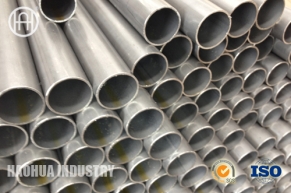Alloy LDX 2101 Duplex Stainless Steel Pipe and Tube

LDX 2101 (Pipe and Tube)
LDX 2101* is a duplex (austenitic-ferritic) stainless steel with relatively low contents of alloying elements. The grade has high mechanical strength, similar to that of other duplex grades. Its good corrosion resistance is on par with that of most standard stainless steel grades. Combined, these properties can be utilised to optimise design with respect to strength, maintenance, durability and long-term cost efficiency.
LDX 2101 main characteristics:
High strength - approximately twice as high proof strength as austenitic stainless steels ASTM 304 and 316
Very good resistance to stress corrosion cracking
Good resistance to general corrosion and pitting
High energy absorption
Physical properties that offer design advantages
Ease of fabrication and good toughness
Very good weldability
Applications
General-purpose applications and environments:
Building and construction
Storage tanks
Reinforcement bars
Water piping
Microstructure
The balanced chemical composition of LDX 2101 results in a microstructure containing approximately equal amounts of ferrite and austenite after annealing at a temperature of 1050°C (1920oF). Due to its relatively low alloying content, LDX 2101 is less prone to precipitaition of intermetallic phases than other duplex steels.
The high nitrogen content results in rapid re-formation of austenite in weld thermal cycles.
* LDX 2101 is a registered trademark owned by Outokumpu Stainless AB
Standards
UNS S32101
Chemical composition (nominal) %
| C | Si | Mn | P | S | Cr | Ni | N | Mo |
|---|---|---|---|---|---|---|---|---|
| 0.030 | 1.0 | 5.0 | 0.04 | 0.03 | 21.5 | 1.5 | 0.22 | 0.3 |
Mechanical properties
Mechanical properties
LDX 2101 has high mechanical strength due to its duplex microstructure and high nitrogen content.
In Table 1 the minimum and typical values for the grade are presented. The mechanical properties at elevated temperatures are shown in Table 2.
| Minimum values | Typical values | |||||||
|---|---|---|---|---|---|---|---|---|
| P | H | C | P (15mm) | H (4mm) | C (1mm) | |||
| Proof strength | Rp0.2 | MPa | 450 | 480 | 530 | 480 | 570 | 600 |
| Tensile strength | Rm | MPa | 650 | 680 | 700 | 700 | 790 | 840 |
| Elongation | Ab | % | 30 | 30 | - | 38 | 38 | 40 |
| Impact toughness | KV1) | J | 60 | 60 | - | 100 | - | - |
| Hardness | HB | 230 | 230 | 230 | ||||
Table 1
P = hot rolled plate. H = hot rolled coil. C = cold rolled coil and sheet. 1) Full size specimen
1 MPa = 1 N/mm2
a) Rp0.2 and Rp1.0 correspond to 0.2% offset and 1.0% offset yield strength, respectively.
b) Based on L0 = 5.65 √S0 where L0 is the original gauge length and S0 the original cross-section area.
Fatigue
The high tensile strength of duplex steels also implies high fatigue strength.
Table 5 shows the result of pulsating tensile fatigue tests (R=0.1) in air at room temperature. The fatigue strength has been evaluated at 2 million cycles and probability of rupture 50%. Since the test was made using round polished test bars from hot rolled plate, correction factors for surface roughness, notches, welds etc, are required in accordance with classical theory relating to fatigue failure. As shown by the table the fatigue strength of the duplex steels corresponds approximately to the proof strength of the material.
| Rp0.2 | Rm | Fatigue strength | |
|---|---|---|---|
| MPa | MPa | MPa | |
| LDX 2101 | 478 | 696 | 500 |
| 2205 | 497 | 767 | 578 |
| 1.4404 | 500 | 510 | 360 |
1.4404 is equivalent to AISI 316L in these tests
Standard deviation of fatigue strength, for the entire population ~ 30 MPa
At high temperatures
If LDX 2101 is exposed for prolonged periods to temperatures exceeding 280 °C (540 °F), the microstructure changes which results in a reduction in impact strength. This effect does not necessarily affect the behaviour of the material at the operating temperature. For example, heat exchanger tubes may be used at higher temperatures without any problems. Contact Sandvik for advice.
| Minimum value | Temperatures | |||||
|---|---|---|---|---|---|---|
| 50 | 100 | 150 | 200 | 300 | ||
| Rp0.2 | MPa | 430 | 380 | 350 | 330 | 300 |
| Rm | MPa | 630 | 590 | 560 | 540 | 540 |
Table 2 - Tensile properties at elevated temperatures:
Physical properties
Physical properties
The physical properties of LDX 2101 are shown in Table 4.
| Temperature oC | |||||
|---|---|---|---|---|---|
| 20 | 100 | 200 | 300 | ||
| Density | x103 kg/m3 | 7.7 | |||
| Modules of elasticity | GPa | 200 | 194 | 186 | 180 |
| Poissons ratio | 0.3 | ||||
| Linear expansion at (20->)oC | x10-6/oC | - | 13.5 | 14.0 | 14.5 |
| Thermal conductivity | W/moC | 15 | 16 | 17 | 18 |
| Thermal capacity | J/kgoC | 500 | 530 | 560 | 590 |
| Electric resistivity | nΩm | 750 | 800 | 850 | 900 |
Table 4
Corrosion resistance
Corrosion resistance
The corrosion resistance of LDX 2101 is generally good, and the grade is therefore suitable for use in a wide range of general-purpose applications and environments.
The corrosion resistance is in general at least as good as that of Cr-Ni grades such as AISI 304L and in some cases as good as Cr-Ni-Mo grades such as AISI 316L.
A brief description of the resistance to different types of corrosion is shown below.
General corrosion
General corrosion is characterised by a uniform attack on the steel surface in contact with a corrosive medium.
The corrosion resistance is generally considered good if the corrosion rate is less than 0.1 mm/year.
The resistance to uniform corrosion in sulphuric acid is shown in Figure 1.
LDX 2101 has a better resistance than AISI 304L and in some cases performs as well as AISI 316L.

Fig. 1. Isocorrosion curves, 0.1 mm/year, in sulphuric acid.
Pitting and crevice corrosion
The resistance to pitting and crevice corrosion increases with the content of chromium, molybdenum and nitrogen in the steel.
The resistance to these types of corrosion, which are mainly caused by chloride containing environments, is good due to the grade's high chromium and nitrogen content.
The pitting corrosion resistance has been evaluated using the Avesta Cell (ASTM G 150).
Figure 2 shows that the resistance is higher than that normally obtained with Cr-Ni grades such as AISI 304L and approaching that of Cr-Ni-Mo grades such as AISI 316L.

Fig. 2. Critical pitting temperatures (CPT) in 1M NaCl according to ASTM G 150 using the Avesta Cell.
Typical values have been given for conventional grades.
Atmospheric corrosion
A steel's resistance to atmospheric corrosion is strongly linked to its resistance to uniform corrosion and localised corrosion such as pitting and crevice corrosion.
Since LDX 2101 shows good resistance to these types of corrosion, it may be assumed that the resistance to atmospheric corrosion is good. Accordingly LDX 2101 should be sufficiently resistant in most environments.
Stress corrosion cracking
Like all duplex stainless steels, LDX 2101 shows good resistance to chloride-induced stress corrosion cracking (SCC).
Many test methods are used to rank the different steel grades with respect to their resistance to SCC. One such test method is the U-bend test according to MTI Manual no. 3, in which the specimens are exposed to 3M magnesium chloride (MgCl2) solution at 100°C for 500 hours. The U-bending was performed both longitudinal and transverse the rolling direction. The results are shown below.
Results from U-bend stress corrosion testing in MgCl2

4301 is equivalent to AISI 304 in this test.
Intergranular corrosion
Due to its duplex microstructure LDX 2101 offers verygood resistance to intergranular corrosion.
LDX 2101passes intergranular corrosion tests according toEN/ISO 3651-2 method A (Strauss) and method C(Streicher).
Such results are as expected for duplex steels, which are less susceptible to this kind of corrosion than austenitic stainless steels.
Heat treatment
Plate,sheet and coil are normally delivered in heat treated condition. If additional heat treatment is needed after further processing the following is recommended.
Solution annealing
1020 -1080°C (1865 -1975°F), rapid cooling in air or water.
Fabrication
Hot forming
Hot forming is performed in the temperature range 1100–900°C (2010-1650oF) and should be followed by solution annealing. It should, however, be observed that the strength is low at high temperatures.
Cold forming
Due to the high proof strength of duplex material, greater working forces than those required for austenitic steel are usually needed for cold forming.
Figure 3 shows the effect of work hardening on LDX 2101. LDX 2101 is suitable for most forming operations used in stainless steel fabrication. However, due to the grade's higher mechanical strength and lower toughness, operations such as deep drawing, stretch forming and spinning are more difficult to perform than with austenitic steel. The grade's high strength, may give rise to a relatively high spring back.

Fig. 3. Mechanical properties of LDX 2101 after cold deformation.
Heat treatment
LDX 2101 is solution annealed at 1020 – 1080°C (1865- 1975 oF). Rapid cooling is recommended after annealing.
Welding
LDX 2101 has a good weldability and can be welded using the same processes used for other duplex steels.
In general the recommendations for welding duplex steels also apply for LDX 2101, however, the restrictions in arc energy are less tight than for conventional duplex steels due to the grade's low alloy content and high nitrogen level.
Suitable welding methods are manual metal-arc welding with covered electrodes or gas shielded arc welding. Welding should be undertaken within the heat input range 0.2-2.5 kJ/mm. Preheating or post-weld heat treatment is not normally necessary.
Filler metals that give an austenitic-ferritic weld metal should be used in order to obtain a weld metal with corrosion resistance and mechanical properties close to the parent metal. For gas-shielded arc welding, we recommend Sandvik 22.8.3.L and 23.7.L and for manual metal-arc welding the covered electrode Sandvik 22.9.3.LR. These filler metals can also be used for welding LDX 2101 to carbon steels, stainless steels and nickel alloys. The covered electrode Sandvik 23.12.2.LR and the wire electrode Sandvik 24.13.L can also be used for dissimilar metal welding. When welding components for use in high concentrated nitric acid Sandvik 23.7.L is recommended.
Products
- Austenitic stainless steel pipe
- Duplex Stainless steel pipe
- Ferritic Stainless Steel
- Fin tubing
- Nickel Alloy steel pipe
- Stainless coils tubing
- Stainless Round & square bar
- Stainless profile shape pipes
- Stainless steel pipes
- Stainless U tubing
- Titanium Alloy steel pipe
- welded stainless steel pipe
- Seamless Alloy Steel Pipes
Contact Us

- Jiangyin Donghao Stainless Steel Tube Co.,Ltd
- Add:No.88,Zhenyang Road, Qingyang Town, Jiangyin City, Jiangsu Province,People's Republic of China.
- Email:Sales@dh-pipe.com
- Tel:0086-512-58220050
- Fax:0086-512-58810865
 dhpipe
dhpipe
 dh-pipe@hotmail.com
dh-pipe@hotmail.com
- Web: www.dh-pipe.com


